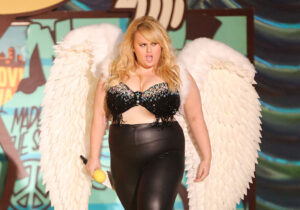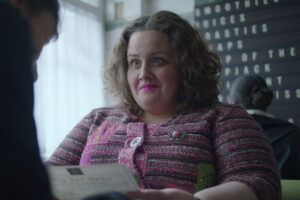Like a lot of vintage B movies, Attack of the 50 Foot Woman is a bad product with a fantastic campaign. I would bet that, since its 1958 release, thousands have owned the poster without ever watching the film: a painting by artist Reynold Brown showing lead actress Allison Hayes as Nancy Archer, straddling a flyover, dressed in nothing but a bikini made of bedsheets, indolently smashing vehicles (and their drivers) onto the tarmac.
There was something titillatingly horrible about a gigantic woman for Fifties audiences. If King Kong had tapped into America’s racial angst, Attack of the 50 Foot Woman was about fear of the uncontrollable woman. The film came out at the high-water mark of the American nuclear family, but the gender settlement was more fragile than it appeared. The same women being urged to smilingly embrace the apron had, not very long ago, been encouraged to pull on overalls in support of the WW2 effort.
Not all of them were happy about the return to domesticity: in 1963, Betty Friedan would formalise this simmering discontent in The Feminine Mystique. Before that, though, Nancy Archer was the problem that had no name personified at superhuman scale. For men, she was a warning about what could happen if you let the women run out of control; for women, she was a threat. “Once a normally voluptuous woman”, says the trailer, Nancy grows “incredibly huge with incredible desires for love and vengeance”. Get too needy, take up too much space, and you too could become “the most grotesque monstrosity of all”.
Size is a feminine phobia: in the kitchen cupboard of my family home, there was a jumble sale copy of a diet book that promised to “trim away unwanted inches” if you followed its directions. On the back pages, there was a helpful set of tables to record your measurements — so, in theory, you could track your glorious shrinking. A previous owner had filled out the first column, and every time I looked at it, I imagined the lonely self-reproach of this unknown woman and her tape measure, taking the circumference of each thigh, knowing that whatever the number, it would be too big.
But the other side of that phobia is a fantasy where impossible stature translates into impossible power. The fact of women’s size relative to men is what makes us vulnerable: what would it mean to be so huge you were untouchable? Which is the question brilliantly asked by the film Love Lies Bleeding, directed by Rose Glass. Set in the world of Eighties bodybuilding, it’s about an intense, obsessive relationship between two women: Kristen Stewart as gym manager Lou, and Katy O’Brian as body builder Jackie who blows in from out of town.
Jackie’s size and strength makes her seem freakish to other people. One of Lou’s sometime-lovers refers derisively to Jackie as “that big girl”. But big is what Lou likes about Jackie, and she introduces her to steroids to help her get even bigger. The doping turns Jackie into “the most grotesque monstrosity of all”. Ripped and ’roided, she is capable of murdering a man with her bare hands. The film drops us inside of her burgeoning drug-induced psychosis, first subtly, by showing her muscles popping and rippling superhumanly; then more fantastically, till the film ends in an all-out homage to Nancy Archer.
But Attack of the 50 Foot Woman had to end with Nancy put in her place: avenged on her cheating husband, yes, but also dead herself. Love Lies Bleeding lets its women have their gargantuan proportions and their revenge on scummy men, without needing to punish them for it. In Glass’s movie, there’s still something deliciously freakish about women who choose size over slightness, but the audience is no longer expected to root for their destruction. In the two generations since the Fifties, “female desire” has ceased to be seen in strictly pathological terms.
It’s not the first time the 50 Foot Woman has been rewritten as a heroine — PJ Harvey’s song “50ft Queenie” is written from the perspective of the giant woman, and has her glorying in her own size. “Come on and measure me,” she commands, and the figures go up through the verses. Here, bigger is better. In 1993, the same year that song came out, the experimental novelist Kathy Acker published an essay called “Against Ordinary Language: The Language of the Body” about her own real-life efforts at hypertrophy.
Acker was a bodybuilder, and had been for about 10 years when she wrote “Against Language”, making her part of the same cohort as Jackie and Lou. Acker describes the discipline like this:
“Muscles will grow only if they are, not exercised or moved, but actually broken down. The general law behind bodybuilding is that muscle, if broken down in a controlled fashion and then provided with the proper growth factors such as nutrients and rest, will grow back larger than before. In order to break down specific areas of muscles, whatever areas one wants to enlarge, it is necessary to work these areas in isolation up to failure.”
This is painful, purposeful work in pursuit of the exact thing the diet book told me to strive against: size. The strict body builder does not live a freer life than the fanatical reducer. As Love Lies Bleeding shows in its relentless montages of egg white omelettes being assembled, achieving a competition-standard physique demands the strictest physical discipline. But the bodybuilder — the big girl — represents a different kind of ideal, one that rejects the ostentatious display of waifish fragility as a status symbol.
It took me decades to go from a fascinated interest in the process Acker writes about, to participating in it myself. Entering the weights room meant breaking two of the taboos that lay heaviest on me: firstly, it meant crossing the invisible gender line around the squat racks and moving into traditionally masculine territory; secondly, it meant overcoming a deep horror of getting big. All my interest in exercise up to that point had been motivated by a desire to shrink myself by torching calories — the voice of the diet book absorbed into my own internal monologue. When I finally came to weights, it was only because I needed to remedy my injuries from running, and I had to reassure myself that female genetics meant I was very unlikely to get big before I felt OK about learning to handle a barbell.
But having overcome that fear, today I find that I am very interested indeed in getting big. It pleases me to see my muscles grow, and to know that this is a consequence of work I’ve done. I’ve got a friend who thinks of bodybuilding as the epitome of individualistic self-improvement, and maybe he’s got a point, but I think of my own strength work differently. My body, which I experienced as a disappointment for most of my adult life, turns out to be a perfectly adapted organism when I use it this way.
And I’m no longer an outlier as a woman in the weights section. The shift in beauty standards, from size zero to Kardashian curves, pushed many women towards bodybuilding as a way of developing the figure they want: if you want a bigger bum, the only way to achieve that without surgery is to build your glutes. A few years ago, I interviewed the author of that diet book (she was lovely, so I feel bad naming her as one of the origins of my neuroses), and asked her about the rise of the butt. She looked simply perplexed by it. She understood that this was what women now wanted, but for someone raised in — and indelibly associated with — the cult of small, it was hard to comprehend.
Still, things have not changed so much. The standards may have shifted, but they have not been destroyed. Bodybuilding for women no longer has the countercultural significance it had for Acker. She saw it as an escape from language into pre-verbal physicality; look around the gym, and you’ll see most exercisers (including me) are skimming Instagram between sets. The big girl is still trapped inside beauty culture, however much she tries to flex her way out of it; still thinking about what her body signifies.
Efforts to theorise the meanings of women’s bodies can be irksome, and the implications of changing trends often contradictory. In her book All the Rage, Virginia Nicholson points out that, while the demise of the rigid corset maps neatly onto the establishment of political freedoms for women, the loose-fitting, limb-baring styles of the Twenties may well have felt more exposing than emancipatory for women. Rising hemlines and less restrictive foundation garments put the body itself on display and under scrutiny, and drove the preference for lean, lithe figures that dominated the 20th century. Gamine silhouettes were associated with freedom, but squint a little and they could look like backlash.
The same goes for the embrace of big. It’s a personal relief to be free of the anxiety to stay tiny, but the pressure to be the correct shape can just mean swapping one set of fixations for another. The fantasy of freedom through strength is, for women, never going to be wholly realised: a strong woman is still weaker than an average man. In the fiction of Love Lies Bleeding, it’s plausible that Jackie can demolish abusive men with her bare fists because we’ve been tipped off that this is part-fantasy. And anyway, without the fantastical element, the revenge she takes would simply be swapping one kind of tyranny for another.
If the pleasure of Love Lies Bleeding is in its hypertrophied excess, for me the pleasure of getting big is in something closer to Acker’s description of the bodybuilding process: the intimacy it creates with failure. To grow strong is to be continually confronted with the fact of your own weakness. Which is as good a metaphor as any for political work women have done to get from the Fifties that made a monster of Nancy Archer, to the present day where supersized Lou and Jackie can be creatures of wonder and desire.
Disclaimer
Some of the posts we share are controversial and we do not necessarily agree with them in the whole extend. Sometimes we agree with the content or part of it but we do not agree with the narration or language. Nevertheless we find them somehow interesting, valuable and/or informative or we share them, because we strongly believe in freedom of speech, free press and journalism. We strongly encourage you to have a critical approach to all the content, do your own research and analysis to build your own opinion.
We would be glad to have your feedback.
Source: UnHerd Read the original article here: https://unherd.com/




